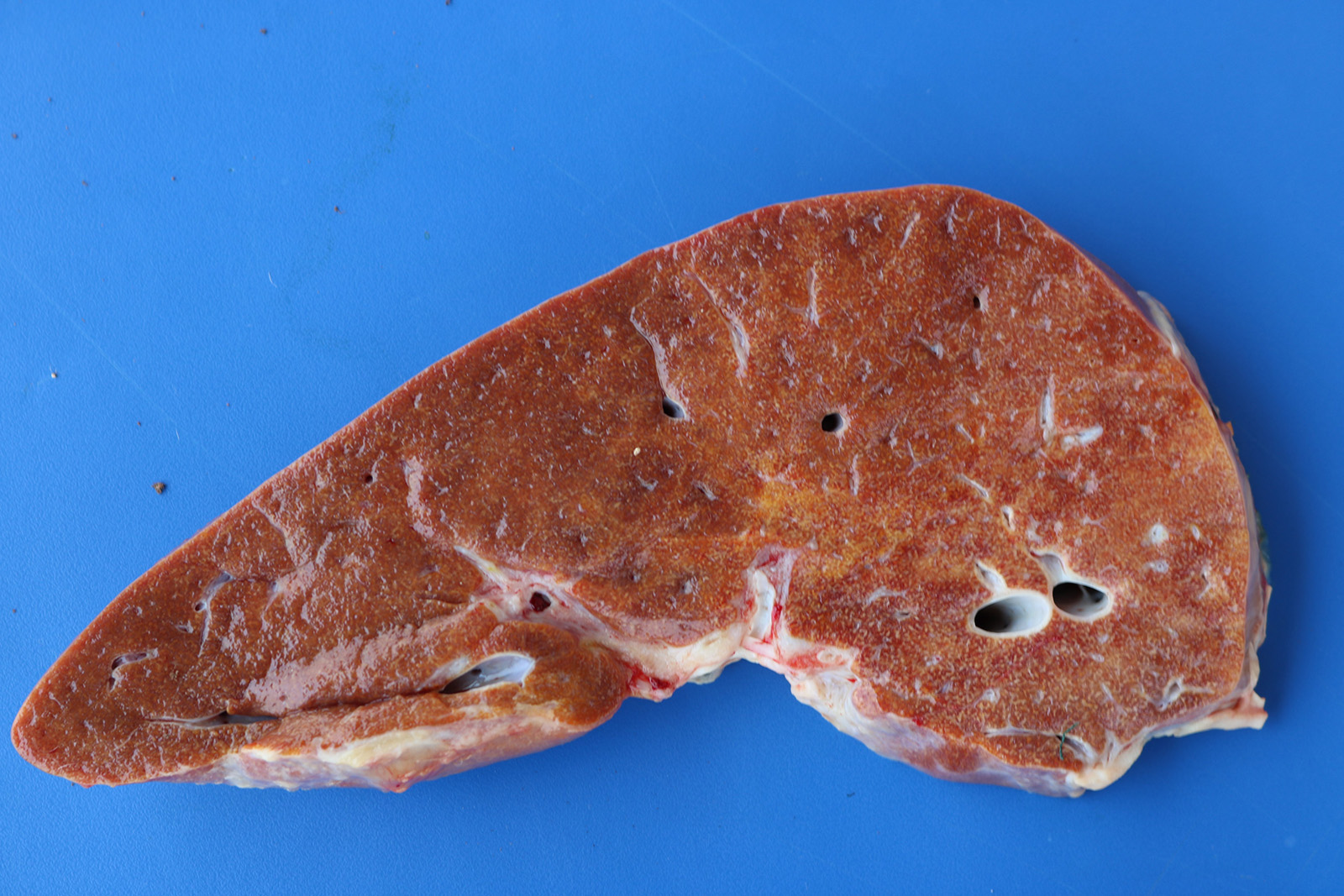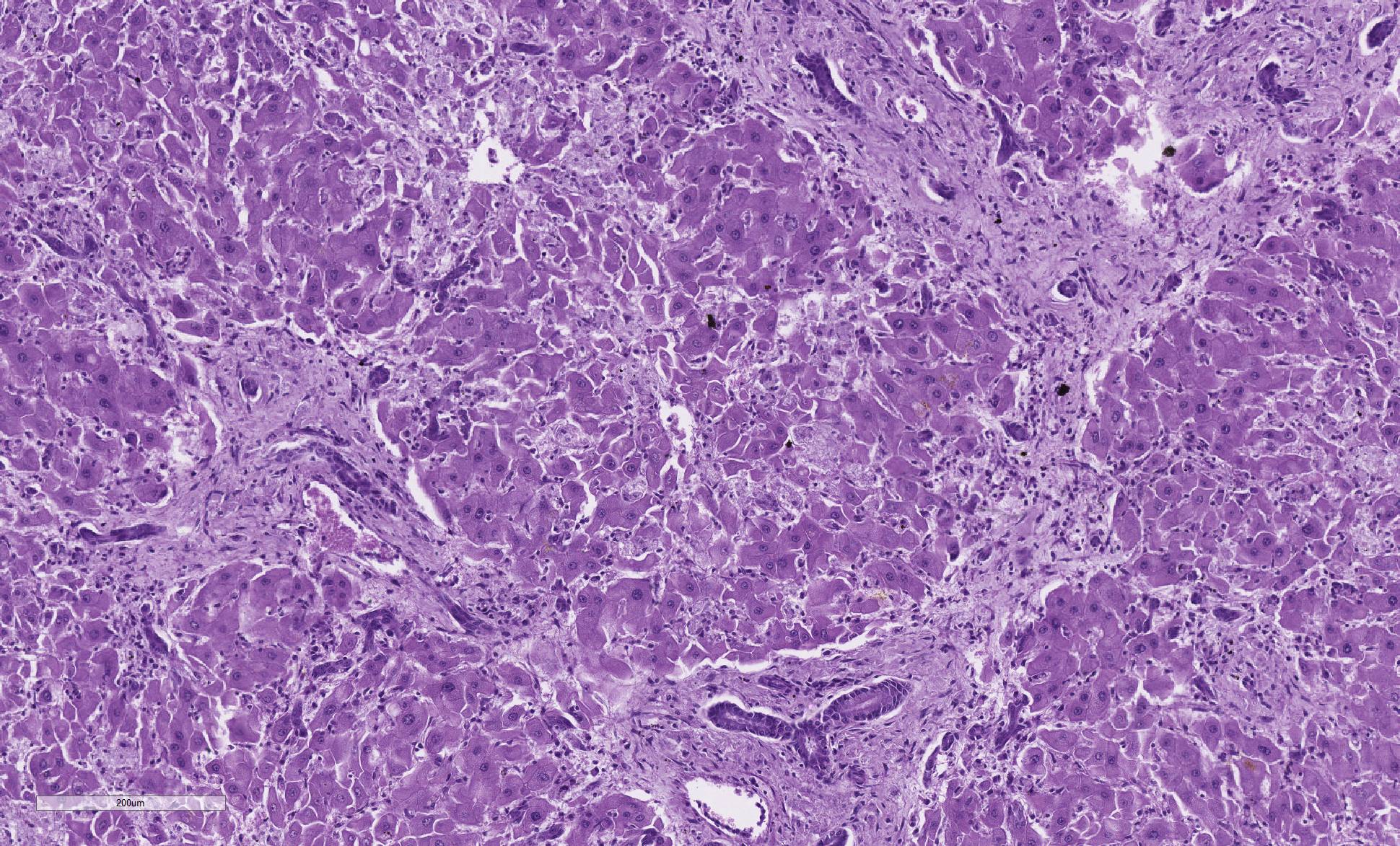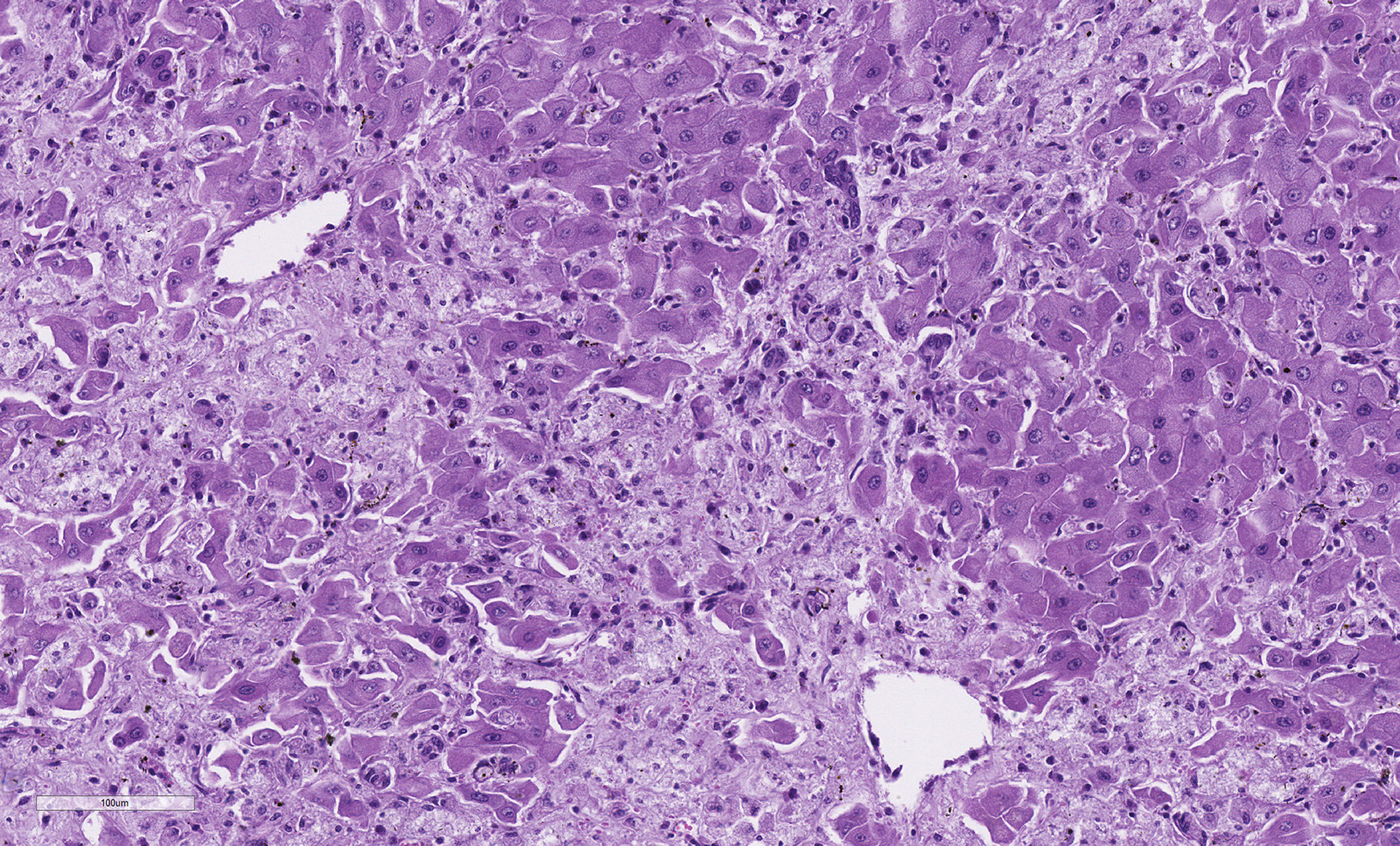Joint Pathology Center
Veterinary Pathology Services
Wednesday Slide Conference
2019-2020
Conference 7
9 October 2019
Dr. John Cullen, VMD,
PhD, DACVP, FIAT
Professor, Anatomic Pathology
College of Veterinary Medicine
North Carolina State University
Raleigh, North Carolina
CASE II: N 544/17 (JPC 4120038).
Signalment: 24-month-old, male, Nelore (Bos taurus indicus), bovine
History: A lot containing 200 steers was allocated on a 125-hectare pasture (Property A) consisting of Brachiaria brizantha. The pasture was heavily invaded by Crotalaria spectabilis. The steers remained in this paddock for two months, when two of them died after showing weight loss, jaundice and increased abdominal volume. After the death of these two steers, another 150 steers of the same lot were shipped to a feedlot (Property B). After remaining for 50 days in property B, another eight steers became ill and died. Three of them were necropsied. Another 15 bovines died on property B in the subsequent two months.
Gross Pathology: The cadaver was in poor body condition, there was about 20 liters of yellowish translucent fluid in the abdominal cavity. The liver was firm and with multifocal to coalescent yellowish areas.
Laboratory results: Analyses for aflatoxin done in the ration fed to the affected steers in the feedlot resulted negative for aflatoxin.
Microscopic Description:
The liver architecture is disorganized by marked fibrosis, multifocal biliary duct hyperplasia and mild to moderate scattered hepatomegalocytosis.
Contributor Morphologic Diagnosis:
Liver, hepatocyte loss, fibrosis, bile duct hyperplasia and hepatomegalocytosis. Lesions compatible with pyrrolizidine alkaloid poisoning.
Contributor Comment: Crotalaria spp. (Papilionaceae) are herbaceous plants and woody shrubs known colloquially as rattlepod or rattlebox because, as the seeds become loose within the pod, they rattle when the pods are shaken.10 There are more than of 600 species in the genus Crotalaria distributed worldwide; most of these species are poisonous for livestock.4 Forty of them were identified in Brazil and C. mucronata, C. juncea, C. spectabilis, and C. retusa were proven toxic for livestock under natural conditions. C. mucronata and C. juncea are associated with interstitial pneumonia3, while C. retusa and C. specatabilis are associated with chronic hepatotoxicosis.2,10 The toxic principle in Crotalaria spp. are dehydropyrrolizzidine alkaloids (DHPAs). DHPAs and their N-oxides are present in plant families such as Boraginaceae, Asteraceae, Orchidaceae, and Fabaceae.8
DHPAs are stable chemical compounds which are biotransformed in the liver by cytochrome P-450 enzymes into toxic metabolites and pyrrole alcohols. These metabolites are alkylating agents that inhibit mitosis, resulting, in the case of the liver, in very large hepatocytes (megalocytes) â a condition referred to as hepatomegalocytosis. As the hepatocytes are lost and dropped out due to necrosis, bile duct proliferation and fibrosis occur.6 At pasture, the Crotalaria poisoning is usually a chronic condition characterized by hepatomegalocytosis, fibrosis and bile duct proliferation.6 However the ingestion of high doses of the plant can cause acute centrilobular necrosis.1
The diagnosis of intoxication by C. spectabilis in the steers of this report was based on clinical signs, an abundance of the plant in Property 1, and pathological changes which are similar to the ones describe in livestock poisoned by species of Crotalaria.6,7 Poor body condition and ascites found in the necropsied steers ruselted from chronic hepatic disease and hepatic failure. Differential diagnosis should include other DHPAs-containing plants such as species of Senecio, Cynoglossum, Amsinckia, Heliothropium, and Echium. Table 1 includes some Crotalaria species and respective DHPAs.4,5
Table 1- Some Crotalaria species and their isolated pyrrolizidine alkaloids4,5
|
Species |
Alkaloids |
|
C. spectabilis |
Monocrotaline, spectabiline, retusine |
|
C. retusa |
Monocrotaline, retusamine |
|
C. pallida |
Integerrimine, nilgirine, acetyl nilgirine, usaramine |
|
C. incana |
Anacrotine, integerrimine, usaramine |
|
C. sagittalis |
Monocrotaline |
Contributing Institution:
Universidade Federal de Mato Grosso, Hospital Veterinário-HOVET, Laboratório de Patologia Veterinária, Av. Fernando Correa da Costa 2367, Bairro Boa Esperança, Cuiabá, MT, CEP 78060-900. http://www1.ufmt.br/ufmt/unidade/?l=ppgvet
JPC Diagnosis: Liver: Fibrosis,
portal and centrilobular, bridging, diffuse, severe, with marked
hepatocellular degeneration, necrosis, and loss, lipogranuloma formation, and
megalocytosis.
JPC Comment: Dehydropyrrolizine alkaloid (DHPA) toxicosis is a common toxicosis of ruminants and herbivores, with up to 350 DHPA containing plant species in the southern US alone (Paul Stromberg, personal communication).
DHPAs can produce disease in animals by a variety of acute
and chronic toxicity and are documented carcinogens. The base chemical is
composed of fused five-members carbons rings; toxic DHPAs have a 1.2
unsaturation. Progressive esterification of the based chemical, such as
diesters and macrocyclic diesters appears to increase toxicity.9
DHPAs required oxidation by cytochrome P450s within the liver to develop their
toxic pyrroles, which react with many essential cellular proteins (including
glutathione) as well as nucleic acids. Hepatocytes, the site of activation,
and endothelial cells are most often affected, resulting in hepatocellular
degeneration and necrosis, with sequelae of fibrosis, biliary proliferation,
and ultimately cirrhosis.9
Most livestock toxicity results when animals consume toxic plants in the
absence of alternative forage, but poisoning also occurs when DHPA-containing
plants are harvested and fed in hay. (This type of toxicity also occurs in
humans; thousands of people in Afghanistan and Tajikistan were poisoned when
DHPA containing plants were harvested and processed into flour.) There is significant
species variation with regard to susceptibility of DHPA toxicity, with pigs and
chickens being considered highly susceptible, cattle horses, and rats
moderately susceptible, and mice, sheep and goats being relatively resistant,
leading to the somewhat risky âpracticeâ of using small ruminants to clear
forage areas containing plants high in PAs.
The disease in poisoned humans is somewhat different than in livestock, with
endothelial damage in the liver predominating. Endothelial damage in humans
leads to fibrosis of hepatic sinusoid and central veins, resulting in portal
hypertension and veno-occlusive disease. Tragically, due to the susceptibility
of human fetuses and neonates, they may develop fatal hepatic disease by transplacental
or transmammary passage of toxic metabolites, while their pregnant or nursing
mothers are unharmed.
A number of tests have been developed in recent years that help to quantitate the toxic and carcinogenic properties of various pyrollizzidine alkaloids, including an in vitro chicken, mouse and rat hepatocyte protocol, an in vivo chick system in which orally dosed chicks are given measured disease of various DHPAs and the damage to their livers measured at 7 days post inoculation, and a carcinogenic model using heterozygous p53 knockout mice which are fed DHPAs in pelleted feed for 12 months, after which they are autopsied and carcinogenic effects in various organs are compared.
The moderator marveled at the amount of
macrophages present in this section, which is not especially characteristic of
most cases of DHPA toxicity, but surmised that it may be another toxic
principle in the pastures grazed by the affected beeves. He suggested the
possibility of concurrent toxicity with a sapinogen intoxicant.
References:
1. Anjos BL, Nobre VMT, Dantas AFM et al. Poisoning of sheep by seeds of Crotalaria retusa: Acquired resistance by continuous administration of low doses. Toxicon. 2010;55:28-32.
2. Boabaid FM, Alberton RL, Ubiali DG et al. Acute poisoning by Crotalaria spectabilis seeds in pigs of Mato Grosso State, Brazil. In: Riet-Correa F, Pfister J, Scild AL, et al. ed. Poisoning by Plants, Mycotoxins, and Related Toxins. Cambridge:CAB International; 2011:148-153.
3. Boghossian, M.R., Peixoto, P.V., Brito, M.F., Tokarnia, C.H., Aspectos clÃnico-patológicos da intoxicação experimental pelas sementes de Crotalaria mucronata (Fabaceae) em bovinos. Pesq. Vet. Bras. 2007;27(4):149-156.
4. Burrow GE, Tyrl RJ. Toxic Plants of North America. 2th ed. Ames: Wiley-Backwell; 2013:535-541.
5. Fletcher MT, McKenzie MA, Blaney BJ. Pyrrolizidine Alkaloids in Crotalaria Taxa from Northern Australia: Risk to Grazing Livestock. J. Agric. Food Chem. 2009;57:311-319.
6. Lucena RB, Rissi DR, Maia LA et al. Intoxicação por alcaloides pirrazolidinicos em ruminantes e equinos no Brasil. Pesq. Vet. Bras. 30(5):447-452.
7. Nobre VMT, Riet-Correa F, Dantas AFM et al. Intoxication by Crotalaria retusa in ruminants and equidaein the State of ParaÃba, Northeastern, Brazil. In: Acamovic T, Stewart CS, Pennycott TW. ed. Poisoning by Plants, Mycotoxins, and Related Toxins. Cambridge:CAB International; 2004:275-279.
8. Stegelmeier, B.L. Pyrrolizidine alkaloid-containing toxic plants (Senecio, Crotalaria, Cynoglossum, Amsinckia, Heliotropium, and Echium spp.). Vet. Clin. North. Am. Food Anim Pract. 2011;27,419-428.
9. Stegelmeir BL, Colegate SM, Brown AW. Dehydropyrrolizidine Alkaloid Toxicity, Cytotoxicity, and Carcinogencity. Toxins 2016; 8(12). pii: E356.
10. Tokarnia, C.H., Döbereiner, J., Peixoto, P.V., Poisonous plants affecting livestock in Brazil. Toxicon. 2002;40:1635-1660.


